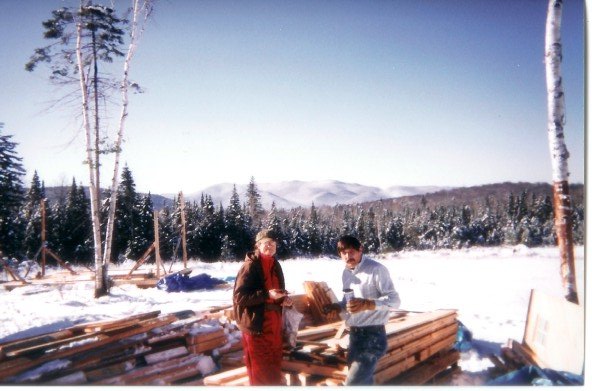In the mid-1980s I ran a summer climbing program called Treetops West - TTW for short - taking adolescents to the Wind Rivers, Tetons, Veedauwoo, City of Rocks, the Needles, and eventually the Andes. That was when I visited the Needles and had my first brush with Gill boulder problems.
John Gill was a legendary climber and boulderer of the 1950s and 1960s. The Needles of South Dakota were one of his stomping grounds. Athletically, and gymnastically his climbing was way ahead of his time, with most of his problems going years, or even decades without a repeat. In fact, for quite some time most climbers were rather dismissive of him spending so much time on this "frivolous" niche activity.
Unlike our modern classifications systems with their copious gradations of difficulty, Gill broke bouldering down into just three categories. A problem which many top climbers had tried, and failed to climb was graded B-3. Once that problem had been climbed it gets relegated to a B-2 problem. He defined "easier" B-1 problems as starting beyond the hardest trad routes of his day, roughly 5.11.
While on TTW I did manage a couple of "easy" Gill B-1 problems. But, my most vivid memory was the day I was standing below the 30 foot high, free standing pinnacle, known as the Thimble. A famous route which Gill relegated to a B-2 problem when he ascended it in 1961. Almost three decades later, it had still not been repeated, as it sported a metal highway guardrail in the landing zone, which would yield a crippling injury in a fall. I climbed up and down the bottom 15 feet of the Thimble; the climbing was hard and technical, and I was memorizing, or "wiring the moves." But, despite encouragement from my cadre of student climbers, it was always clear to me that it was out of my league, and that, I certainly was not going to "go for it."
Several evenings later, after my TTW group had checked out more Gill problems I did this impressionistic watercolor in my trip journal.
skip to main |
skip to sidebar

Hock on the 5.7 "Razor" Pitch

Selden and Gary getting ready to frame the cabin

Fossils on Ishinca (18,500')
A bunch of old guys still enjoying the mountains, and the training they need to do to get off the couch
Books I Am Reading
- Paths Of Glory
- Shieldmaiden
- The Mountaineer’s Companion
Total Pageviews
Popular Posts
-
KURTYKA WAS A LEADING PROPONENT OF FAST AND LIGHT IN THE 1970s and 1980s. This is a historically important essay written in 1988. The Art ...
-
Yesterday I skied on the Whiteface toll road for 90 minutes. It was covered and skiable from the bottom gate … but it was pretty darn icy....
-
I remember reading the 1978 Outside magazine, and saying "HOLY SHIT." Over the years, I read all of the books cited, as well as a...
-
Lenny had a break from classes in Belgium, so he tracked me down in Zermatt. I was living the true Dirtbag existence, bivying on a farmers ...
-
I was away for a few days for the funeral for Sue Klinkow. She was a wonderful person, and long time spouse to "Klink" one of my c...
-
I have three types of warmups I do before I go skiing in the winter: 20-30 minutes on the exercise bike or ergometer, or 20-30 minutes with ...
-
Warm temperatures and rain in the past 36 hours decimated the snowpack. However, there is enough coverage for some sledding on the small hil...
Blog Archive
-
▼
2024
(442)
-
▼
May
(34)
- The “Norwegian Training Method”
- Skyrunning … where trail running meets mountaineering
- Kikkan … the film on YouTube!
- BLAST FROM THE PAST … my only trip to Needles in t...
- Impossible Dream Boulder still unclimbed
- Another book from Hock’s Alpine Library … a histor...
- Great video about one of Bonatti’s greatest routes
- Perusing INTERNATIONAL SKI HISTORY ASSOCIATION vid...
- 50th College Reunion Bike Ride … 33k
- BLAST FROM THE PAST … the impossible dream boulder...
- Lake Placid to host Nordic World Cup Final in 2026
- Another book from my shelves … RUNNING WILD
- Three week countdown until the Sierras!
- Excellent day at Union
- 50th College Reunion
- Slovak Direct on Denali
- A GREAT ESSAY … Is skimo as silly as it seems
- A possible PR on yesterday’s run up Mount Van Hoev...
- BLAST FROM THE PAST … the blatten chapel
- Lots of rain but managed some good training
- What does fatigue resistance depend on?
- BLAST FROM THE PAST … old sketchbook and planner
- Nice run on the Jackrabbit Trail
- Excerpt from Rick Ridgeway’s book
- Another book from the Hock Alpine Library .., Ultr...
- Potential Adventure Goals For 2024-25
- Lucy Wins The Big A 50k
- Excellent start to the new training year
- Simple power test for fossils
- TRAINING GOALS FOR 2024-25
- Outside magazine book review of EVEREST INC.
- Quick analysis of my 2023-24 training year
- Walmsley … excellent new video
- Last day of 2023-24 training year
-
▼
May
(34)
Important Climbing And Skiing Website Links
Aiguille de Gliere

Hock on the 5.7 "Razor" Pitch
Hock's best. What were your Five biggest and best routes?
- South Ridge of the Gliere
- North Ridge of the Grand Teton
- North Buttress of Middle Cathedral
- Sentinel Rouge on Mount Blanc
- Black Dike on Cannon
Hock's handful of could have, would have, wished I had, and still hope to do routes!
- West Face Tocllaraju
- North Face of the Matterhorn
- Black Ice Colouir on the Grand Teton
- Cassin Ridge on Denali
Fossil Clubhouse

Selden and Gary getting ready to frame the cabin
Cordillera Blanca
Fossils on Ishinca (18,500')











